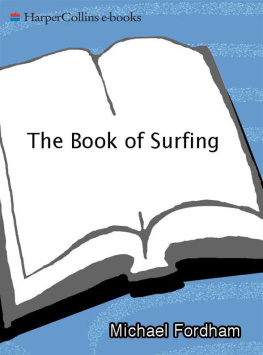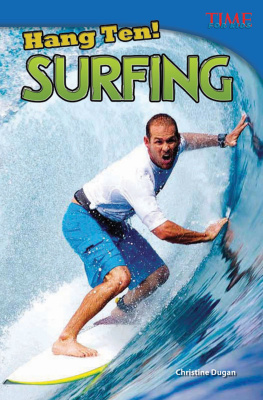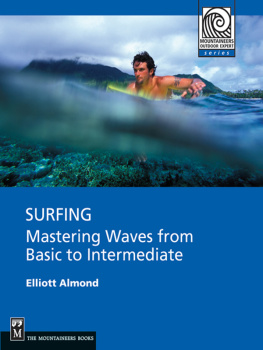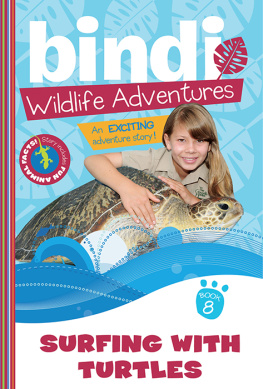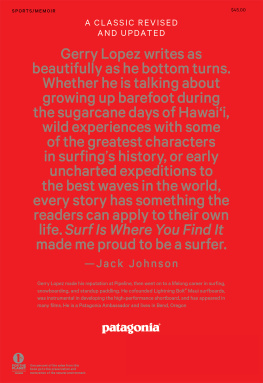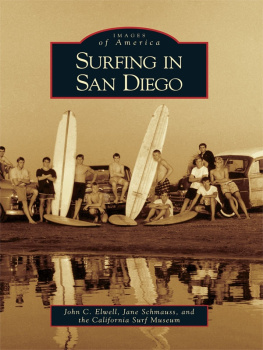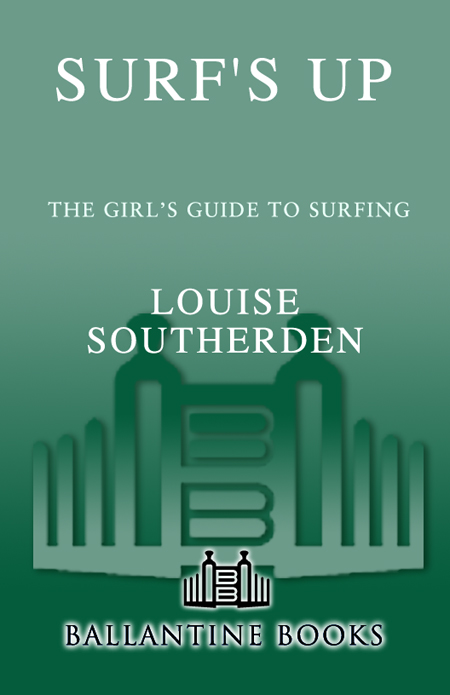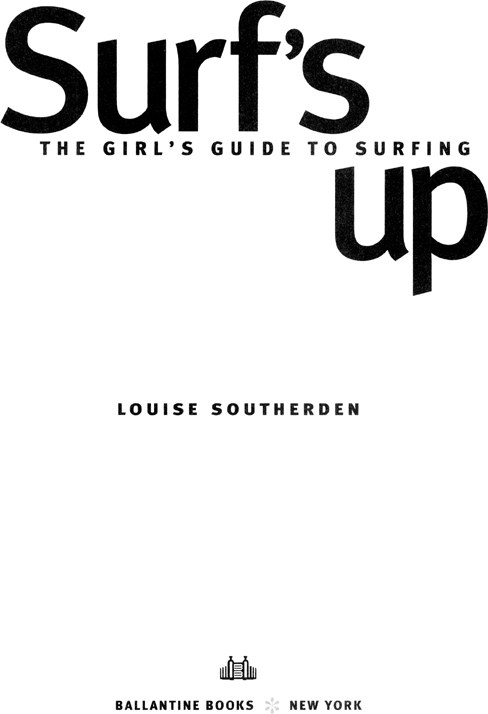thanks
A frangipani to the following people who helped in ways great and small: The surfer girls interviewedAngie Gosch, Belinda Glynn, Esther Hamburger, Alison Aprhys, Loata Sanderson, Emy Tesoriero, Bethany Currin, Deborah Stoll, Anna Cooper, and Kaitlyn Margesonfor openly sharing their insights and experiences of the learning-to-surf curve. Janet Boyd, my Montauk, Long Island, friend, who helped so much with the research for this US edition; as did Jim Regan, who is truly the best friend a writer could ever have. Christine Schiedel for her beautifully creative design of the book. Izzy Tihanyi of Surf Diva Surf School, Karina and Erik Petroni, Bethany Hamilton and her manager Roy Hofstet-ter, John Radcliffe at Dripping Wet Surf Co., Penny Lane of Manly Surf School, Shawn Ambrose of Trixie Surfboards, and surf coaches Mary Setterholm, Priscilla-Anne Hensler, Anna Santoro, and Ross Phillips at Surf Schools International, for their input. Kirsten Trem-lett for the surf stretches. Kathy Phillips of the Eastern Surfing Association, Marie Case at Board-Trac, Michael Gerard at Surfing America, Bryan Dickerson and Sunshine Makarow at Surf Life for Women, Tom Dugan at Eastern Surf Magazine, Todd Leetch at Girl in the Curl surf shop, and Nick at Hansen's Surfboards, for helping with the research. Layne Beachley for the inspiring foreword and for being such an upstanding role model for surfer girls everywhere. Pro surfers Rochelle Ballard, Serena Brooke, Kate Skarratt, Prue Jeffries, and Jodie Nelson, for their quotes and for giving women's surfing a higher profile than ever before. For assistance in researching the history of women's surfing, I thank Ray Moran of Manly Life Saving Club; Tina Graham of Warringah Library Local Studies Unit; Girl in the Curl: A century of women in surfing by Andrea Gabbard (Seal Press, Seattle, 2000); The Glide: Longboarding and the renaissance of modern surfing, edited by the late Chris Bystrom (Duranbah Press, Queensland, 1998); and Blue Heaven: The Story of Australian Surfing by Murray Walding (Hardie Grant Books, Victoria, 2003). Betty Leighton for permission to use one of the late Ray Leighton's photographs (page 8). Ocean & Earth for the Karlee Mackie images (Chapters 2 and 10). Rick Irons at Pri-media for permission to use the Surfer magazine cover featuring Lisa Andersen (page 24). Photographers Neil Armstrong (Moon-walker), Joli, Simon Williams, Will Burgess, Jon Wellings, Jon Steele, Josh Kimball, and Noah Hamilton, for their beautiful images. This US edition would not have happened without Marie Beard at Allen & Unwin. Heartfelt thanks too to my editor, Allison Dickens at Random House, who has been a joy to work with, on many levels. And finally warm, sunny thanks to you, the reader, for making the efforts of everyone mentioned here all the more worthwhile.
foreword
The ocean is constantly changing and is impossible to control, and yet, as surfers, we need a strong ability to read and understand it. We have to learn how to read the sandbanks, the currents, the movement of the swell. We have to understand the effects of the wind and swell and tidal changes on where and when waves break. We need to be able to determine how each wave breaks, how far out it's breaking, how far in, if it's a left or a right, if it's hollow or fat, fast or slow. Confused yet?
If you are, that's okay, because you're holding in your hands one of the most valuable tools a surfer girl could have. Surfs Up: The Girl's Guide to Surfing tackles everything you need to know both in and out of the water, saving you time, energy, and embarrassment!
I wish I had this book before making the trek down to Manly Beach in Sydney when I was learning. Intimidating guy surfers, a lack of skill, and little understanding of surfing etiquette were just some of the many hurdles I had to overcome, on my own, as a novice surfer. None of this stood in the way of my surfing passion, of course, and you shouldn't allow it to stand in your way either.
Surfing is a challenge, but that's why we love it, that's what makes it so special. Whenever I'm at the beach, my senses open as soon as my feet touch the sand. The fresh smell of salt air, the sound of the crashing swell, the soothing immersion in the water, the sight of dolphins playing and fish frenzying beneath my board. The world of surfing is just thata whole new world waiting to be discovered by you. I hope the words of wisdom in the following pages help you in all ways to get out there and find your own special moments in the water.
Layne Beachley
Six-time world surfing champion
June 2004
author's note
Six months ago, I had the worst wipeout of my life. I was surfing at a beach break five hours north of Sydney with my friend Jim when I misjudged the takeoff on a set wave and went down with the lip. I didn't hit the bottom, but I hit the water so hard that my head bent too far forward, pinching my spinal cord and paralyzing me from the neck down. I had one thought: This is it.
Finally, after what seemed like a lifetime underwater, I floated to the surface face up and started calling for help. All I could do was float on my back and wait for the waves to wash me onto the beach. But Jim had seen my wipeout, and within minutes he and two other surfers were sliding me onto his longboard and carrying me to the beach; from there I was airlifted to a local base hospital and then to Sydney. It turned out that I was supremely lucky that day; my spinal cord was only bruised, not broken. I spent two weeks in the spinal unit of a Sydney hospital, and three months after that, getting the feeling and movement back in my arms and legs.
It might seem strange to start a learn-to-surf book with such a story, but I'm telling it to inspire you, not to scare you, because I think surfing actually saved my life. After a lifetime of wipeouts, I didn't panic when I was underwater for so long. I didn't lose consciousness or swallow any water. I knew to stay calm, relax as much as I could, and trust that the ocean would release meand it did. Because I was relatively healthy and fit, my body healed itself quickly. Most important, being a surfer meant that I had the ocean for my rehabilitationI spent all summer floating and then swimming in the ocean, gradually swimming farther out past the breaking waves to where I felt most at home. I even repaired my wetsuit (it had been cut off my body when I arrived in hospital) as part of my therapy. Stitch by stitch, I hand-sewed my life back together. Being a surfer may not make you immune to life's down times, but it can give you skills to ride them out.
Now, as I've been working on this completely revised edition of Surfs Up, tailor-made for American surfer girls, I'm rediscovering my love of surfing. Last Saturday I tried out my new improved wetsuit for the first time at one of my favorite surf beaches. The waves were overhead but full because of the high tide, and three of my friends were surfing, so I decided to paddle out to sit out the back with them. It took me a while to find the right moment (and the courage) to get through the shorebreak, but as soon as I started paddling it was like I'd never been away. After six months, it was reassuring to know it was all still theremy love of the ocean environment, feeling at home sitting on my board in deep water with other surfers, my sense of where the waves were and where it was safe to sitand to feel a fresh appreciation for this incredible lifestyle we enjoy as surfers.


